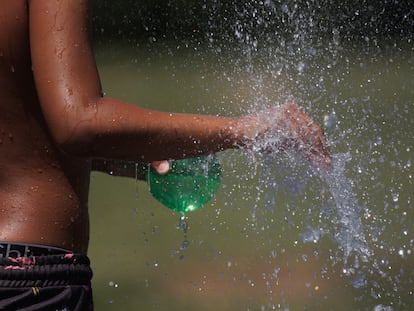Extreme heat: How eight cities are innovating to fight rising temperatures
From shade maps to applications to find drinking fountains and from drainage systems to white roofs, cities are looking for solutions to create cool spaces
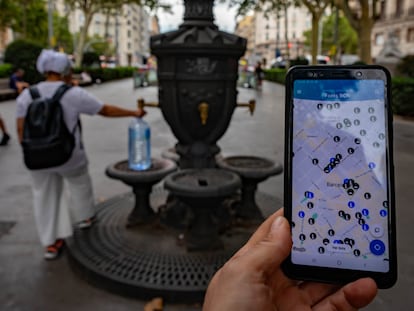
Spanish cities are preparing to cope with increasingly extreme temperatures driven by anthropogenic climate change. From shade maps to apps to find drinking fountains and from drainage systems to white roofs, cities are looking for innovative solutions — some of them based on traditional methods — to help city-dwellers alleviate the effects of the sweltering heat.
Naming heat waves
The last temperature spike in Seville last June entered the category of a heatwave, and it even had a name: Yago Sevilla. Since 2022, the capital of the Andalucía region of Spain has been participating in the proMETEO project. This is a highly innovative pilot initiative for adapting to climate change in cities. The app names local heat waves that pose a very high risk to health. This is the same thing that has been done for years with other meteorological phenomena, such as hurricanes or storms.
“Our analysis is purely local and focuses not only on meteorological issues, but also on the information we have on the impact of these episodes on the population,” explains José María Martín Olalla, scientific head of the initiative. He maintains that retrospective data from the last 28 years shows a clear relationship between extreme temperature and mortality. According to the University of Seville professor, naming heat waves helps to make their importance visible to the public. “We don’t name just anything, only special episodes,” he stresses. They already have the next one in mind: Xenia Sevilla.
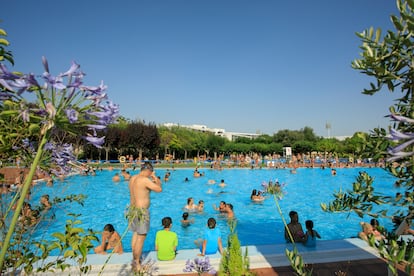
Leisure for extreme temperatures
The entrance fee to Zaragoza’s municipal swimming pools for an adult is €4 (US$4.38) from Monday to Friday and €4.70 (US$5.15) on Saturdays and holidays. This rate is reduced by half in cases of extreme heat, a discount that is automatically applied when the Municipal Civil Protection Plan for high temperatures is activated (something that has not yet occurred this year). As Francisco Heras, an expert in adaptation at the Spanish Climate Change Office, stresses, one of the key points is to offer cheap or free leisure outings where people are not exposed to high temperatures. “There must be other alternatives to the heat than taking refuge in air-conditioned bars or shopping malls.” The authorities in Gines (Seville) leave their swimming pool open until 12.30am on the hottest days, and it is free for those registered residents of the town. “It’s an extraordinary measure every time there are yellow or orange [extreme heat] warnings. It is very successful, especially among young people and families. Many people come to the pool with their dinner and spend a pleasant evening,” explains a municipal spokeswoman.
Heat waves: what’s coming is worse
Cooling centers are also available. “These are public facilities such as libraries, social facilities, among others that offer a cool environment. Barcelona is the city that has the most structured network and informs its citizens about it,” says Javier Martín-Vide, professor of Geography at the University of Barcelona (UB). The model is beginning to spread to cities such as Seville, Málaga and Murcia. Parks with lush trees and fountains can also be considered cooling centers.
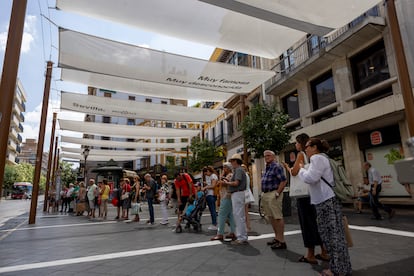
Shade map
Zaragoza is also one of the first Spanish cities to offer its citizens a shade viewer of its streets. This map shows the shadows cast by buildings on a specific day and at a specific time. It allows you to trace a route through the city, prioritizing the roads that are less exposed to the sun’s rays. As detailed by María Jesús Fernández, head of the municipal Participation Office, this tool has been developed through the Spatial Data Platform of Zaragoza (IDEZar) and the idea is to add layers of information. Right now, it is already possible to include different types of locations (such as museums, bookstores, sports centers, etc.) in the interactive map to better design a hypothetical route. “In the future you will be able to add a layer that includes the trees and their shadows,” he insists. Beyond this practical use for getting around the city, this viewer also helps to see cities from a very different point of view. Tourist sites, green spaces, and leisure areas are no longer the only significant features on the city’s map. Just as important is how to plan a walk through the city streets on a very hot day.
Water for drinking and cooling off
Some of the measures to adapt to climate change consist of taking up ideas such as putting public fountains back into use. To prevent heat from becoming another factor of inequality, cities need to provide free water in the streets to allow drinking or cooling off in times of high temperatures. For example, Barcelona has even made an app available to its citizens to find the locations of 1,714 drinking fountains dotted around the city; Madrid also displays its 2,150 fountains through the Madrid Móvil application.
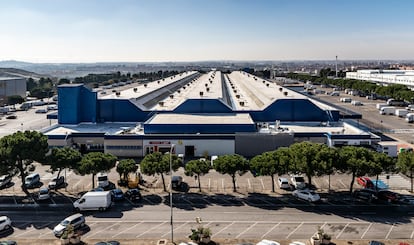
“Parks with water jets on the ground that allow them to become an enormous shower for people, and especially for children, are a very positive idea. Water is a distinctive element of good quality public spaces, although it is necessary to invest in maintaining them,” explains José María Ezquiaga, winner of the National Urbanism Award. One example is the so-called urban beach at Madrid Río, in the capital, a fountain with jets that periodically spurt from the ground and where bathing is allowed, which delights children on the hottest days. The fountain — which operates from 11 a.m. to 9 p.m. in summer — has three wet enclosures with three different effects: surface sheet, where users can lie down and soak; high water jets; and clouds of sprayed water.
Sun awnings
“In Seville, awnings have been put up in Sierpes street and other similar streets in the center. They are very useful to create shade and avoid ultraviolet radiation in downtown streets where it is difficult to put trees. They are retractable so that they can be removed at night, when they would accumulate heat,” says UB’s Javier Martín-Vide. It is a model shared by other cities in the south of the Peninsula, such as Jaén and Córdoba, and with the increase in temperatures, it is foreseeable that it will extend to many more. Juan José Galán, professor of Urban Planning at the Polytechnic University of Valencia (UPV), emphasizes that this system “adapts very well to old towns with narrow streets, where they are an ideal solution.” In addition, arcaded areas such as those found in the main squares of many Spanish cities offer plenty of space out of the sun.
Cooling roofs
Highly exposed to solar radiation, the roofs of buildings have the potential to be improved in many ways. “In Madrid, a cold roof has been installed on a Mercamadrid warehouse. The white material that the roof is made of both reflects radiation and absorbs less heat. It is a more expensive roof but it has environmental and thermal benefits,” says Ester Higueras, coordinator of a European project on urban adaptation to climate change and professor of architecture at the Polytechnic University of Madrid (UPM). According to Madrid City Hall, this measure affects 33,000 square meters and reduces the indoor temperature by up to five degrees. It is the same concept that has traditionally been used for whitewashing houses on the Mediterranean coast.
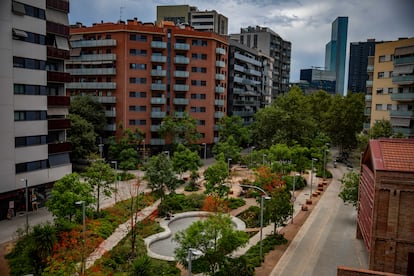
A further step is to convert roof space into a green area, as Barcelona is doing with the Terrats d’en Xifré (a large park on top of the terraces of six buildings), and Madrid with the green roof of the Eduardo Úrculo cultural center. Martin-Vide, from the UB, points out, “Green roofs are starting to be built on some public buildings, but they should be mandatory on all new private real estate developments, because they serve to green the city and lower the temperature in the buildings.” To promote this, Barcelona City Council has published a guide to help install green roofs on buildings.
Regreening cities
“Faced with the heat, it is essential to renaturalize urban spaces by planting trees, as they provide shade and, above all, a cooler microclimate thanks to evapotranspiration,” explains Marta Vall-llosera, president of the Superior Council of Spanish Architects’ Associations (CSCAE). Urban planner Ezquiaga goes further: “The effort to plant trees should be a basic principle of all activity in the city. Now the technique even allows it to be done on concrete decks, as was done in Madrid Rio.”
Juan José Galán (UPV) highlights the example of superblocks, streets in which traffic is reduced and public spaces are created with trees and vegetation, as Barcelona is doing in several neighborhoods. “These are projects with social, economic, and environmental sustainability,” he notes. The idea has also reached Valencia, which is refurbishing Pérez Galdós avenue — with narrow sidewalks and no trees — to widen the pedestrian space and plant trees. Galán also defends the creation of urban parks: “Valencia did it in the eighties with the Turia Garden, which took advantage of the old riverbed to create the central axis of its green infrastructure. It’s a green strip that runs through the city, where you don’t hear a sound, and where the temperature is much lower.” A concept similar to that of Vitoria’s green ring, also built on a river.
Taking advantage of the rain
Rainfall is also an ally when it comes to reducing the temperature, but the impermeable asphalt of the cities and the sewage system cause the water to disappear quickly. In order to take advantage of and prolong the rainfall effect, it is necessary to rely on sustainable urban drainage systems. Josep Roca, professor emeritus at the School of Architecture of the Polytechnic University of Barcelona (UPC) and an expert in heat waves, explains, “These are environments that regreen the public space with vegetation and biodiversity, but also have a permeable soil that collects water when it rains, sends it to the subsoil and allows it to stay cool, which in turn lowers the temperature.” The goal is for the water to stay in the city longer, because that cools the environment and helps the plants cope with heat stress. He gives as an example the one created in Cristóbal de Moura street in Barcelona, although there is also another one in the Atalayuela park in Villa de Vallecas, Madrid.
All the experts consulted are in favor of reducing asphalt and concrete surfaces, which absorb a lot of heat during the day and emit it at night, and replacing them with more natural materials. “It is essential to increase the permeability of urban pavements, so that they absorb water and generate green spaces,” explains Vall-llosera (CSCAE).
Sign up for our weekly newsletter to get more English-language news coverage from EL PAÍS USA Edition
Tu suscripción se está usando en otro dispositivo
¿Quieres añadir otro usuario a tu suscripción?
Si continúas leyendo en este dispositivo, no se podrá leer en el otro.
FlechaTu suscripción se está usando en otro dispositivo y solo puedes acceder a EL PAÍS desde un dispositivo a la vez.
Si quieres compartir tu cuenta, cambia tu suscripción a la modalidad Premium, así podrás añadir otro usuario. Cada uno accederá con su propia cuenta de email, lo que os permitirá personalizar vuestra experiencia en EL PAÍS.
¿Tienes una suscripción de empresa? Accede aquí para contratar más cuentas.
En el caso de no saber quién está usando tu cuenta, te recomendamos cambiar tu contraseña aquí.
Si decides continuar compartiendo tu cuenta, este mensaje se mostrará en tu dispositivo y en el de la otra persona que está usando tu cuenta de forma indefinida, afectando a tu experiencia de lectura. Puedes consultar aquí los términos y condiciones de la suscripción digital.
More information
Archived In
Últimas noticias
Welcome to the post-religion era: The idea of Christianity as the absolute truth has become obsolete
‘I thought you would like it’: The risky sexual practice popularized by TV shows and TikTok
The digitalization of tourism: ‘They promise experiences and gave us the worst possible one’
Mexican peso defies uncertainty with forecasts of a new period of stability in 2026
Most viewed
- Sinaloa Cartel war is taking its toll on Los Chapitos
- Reinhard Genzel, Nobel laureate in physics: ‘One-minute videos will never give you the truth’
- Oona Chaplin: ‘I told James Cameron that I was living in a treehouse and starting a permaculture project with a friend’
- Why the price of coffee has skyrocketed: from Brazilian plantations to specialty coffee houses
- Silver prices are going crazy: This is what’s fueling the rally

